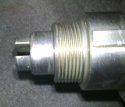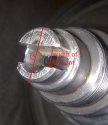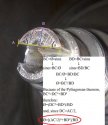I agree about the fact that the mass of the missing tab/supplementary weld is too little and close to the rotation axis to affect the balance.
My opinion about the situation has evolved a bit when I started thinking about this statement:
single tab will put too much side-load on the pump, maybe wear it out prematurely.
, which has been written elsewhere, too by other people about the same problem.
I haven't measured neither the slot between the two tabs, nor the width of the tab of the oil pump shaft which meshes with them, but there must be some clearance between them, otherwise they would need a perfect centering of everything (crankcase cover, oil pump in the cover, etc.) to mesh properly and I doubt that such tolerances would be achievable.
A little drawing can explain faster and better what I think about the way they work together and what can happen if they are not centerd; in black the tabs of the crankshaft and in red the one of the oil pump shaft:

I actually have a hunch that even in an undamaged crankshaft the situation is a little like the one in the bottom of the picture and that one of the tabs is just supposed to never touch the pump shaft!.
I'd really like to see the result of some engineer's blue applied to the mating surfaces of an undamaged bike (apply blue - install cover - spin crankshaft by turning the rear wheel with 6th gear engaged - check the contact area).
My ultimate theory so far is that maybe the tolerances are tight and so contact of both the surfaces like in the top of the picture will be achieved when the tabs wear a little, or maybe it's achieved by the fact that the conact points/lines actually become surfaces with just elastic deformation (read page 2
here: «In reality, a small contact area is being created through elastic deformation, thereby limiting the stresses considerably»).
So the bottom line is that if you weld the tab too close to the other one, they won't let the pump shaft slide between them and if you weld them too far apart, the one welded will never touch the shaft anyway. An idea could be to weld it a little too close and adjust it with a file until it meshes, if the steel of the crankshaft is not too hard; if it is, a little rotary tool should work. But maybe some clearance is needed... I'm not so sure about what should be done anymore.
And here is another solution, a
compromise:
consider that, in our engine:
•the crankshaft is soaked in oil
•the timing chain delivers oil to the head
so, probably, if that oil pump fails, the engine won't seize in a second.
You could even not weld it, reinstall everything and use the bike. Once in a while, you turn on the engine and loosen a little the banjo bolt over the oil pump, the one which brings oil to the head, and make sure that it leaks some drops of oil: in that case, the pump is probaly working. If it doesn't leak oil, you turn the enine off immediately and check it.








